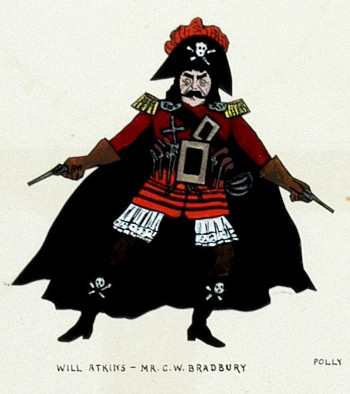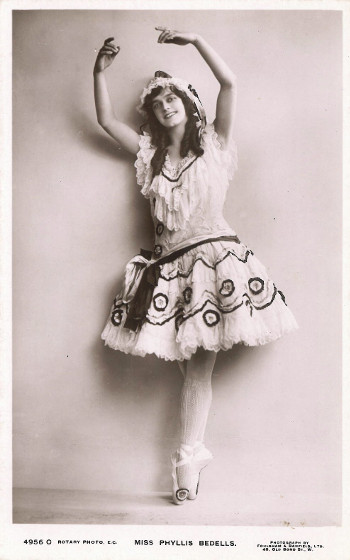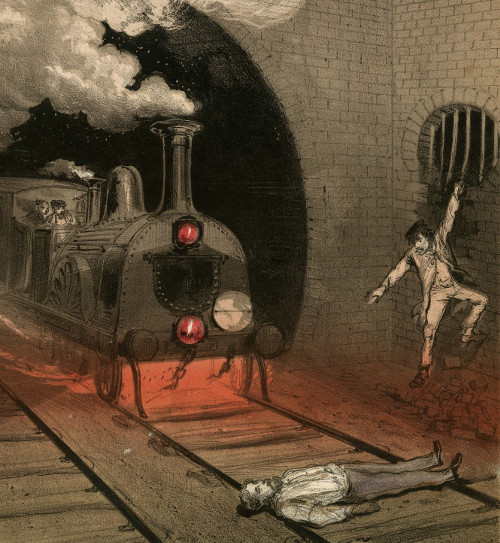Archives Hub feature for March 2016
APAC, the Association of performing arts collections in the UK and Ireland: A peer network championing the documentation of performing arts material and its access by everyone.


The Association of Performing Arts Collections, APAC, was founded in 1979 by a number of librarians, archivists and museums curators, as the then Theatre Information Group. Its mission is to champion best practice in documenting the performing arts and making it accessible to their users. The peer network of information professionals and interested individuals has grown to almost 100 members and includes institutions responsible for most of the UK’s performing arts heritage: public museums, libraries, and archives; archives of theatres and companies; college and university archives and libraries. APAC is the UK and Ireland affiliate of SIBMAS, the international organisation of libraries, museums, archives and documentation centres of performing arts. The national and international network of collection managers provides an excellent forum for information exchange, to discuss issues and explore solutions.
The APAC Executive Committee arranges regular meetings, alongside visits to collections and performing arts venues in addition to conferences and study days concentrating on issues of relevance to our holdings, such as copyright, digital preservation, audio-visual materials, costume, photography, digitisation, exhibitions, etc. These events are aimed at updating and extending members’ knowledge and skills, but also to benefit from each other’s trials and errors and encourage collaborative projects. In addition APAC has a number of working groups bringing together APAC members discussing specific challenges in their day-to-day work and seeking solutions, which are shared with the wider membership. Current working groups concentrate on digital preservation and authority datasets for performing arts.
One major challenge faced by most organisations holding performing arts materials is the fact, that international documentation standards for archive, library and museum collections do not adequately allow the capture of production/event information, which includes details of the work, its venue, production run and creative and cast involved. Many theatre and performance venues managing their own collections have implemented solutions to document their performance history and then to link these up with relevant material held within their organisation. Excellent examples are the National Theatre Archive, the Royal Opera House Collections, the Royal Albert Hall or the archives of the Royal Shakespeare Company held by the Shakespeare Birthplace Trust. However, much related material is held by other organisations across the country, which tend to not have equivalent production databases due to lack of resources, both time and money. Also organisations, such as museums, local libraries or archives do not want to duplicate the effort of re-entering performance data in their own systems and then just link up their own material.

The technical developments and online opportunities over the last decade led to APAC’s main vision of establishing an www.IMDB.com style solution of making a single database freely available online, where past and current productions across the UK and Ireland can be recorded. It is not only the ambition to facilitate a single point of access to find out about production, cast and venue information, but also to make the link to actual holdings held by organisations across the two countries. This ambitious project will hopefully see the closing of the major information gap, but should also result in a new and innovative way of making material discoverable using technology readily available. In tandem with technical developments, the APAC Authority Working Group, comprising of information professionals across the sector plans to draw up guidelines on how to use this resource alongside your in-house archive, library or museum system.
To find out more about APAC, please check out the APAC website, which holds information about APAC members and other resources, which may be of relevance to other organisations: www.performingartscollections.org.uk.
And now it is time to meet some of the APAC members holding archival collections and making these available via the Archives Hub:
Central Saint Martin’s Museum & Study Collection
The Central Saint Martin’s Museum & Study Collection has been collecting work by students and staff for more than a century and for the last 20 years has bought work from degree shows. There has been a theatre design department (now called Design for Performance) for much of that time and the collection now includes dress research, costume designs, theatre models and photographs from that department. Drama Centre London is also part of Central Saint Martin’s, and the museum has some of their material.
http://www.arts.ac.uk/csm/about-csm/museum-and-study-collection/
National Theatre
The National Theatre Archive documents, protects and makes accessible material related to the history of the theatre. The NT Archive collects around productions as well as the administrative and strategic history of the institution. Its external collections focus on the early days of the National Theatre and on staff members, who were integral to its development.
A couple of the external collections are on the Hub with more to come. The Shakespeare Memorial National Theatre Collection (https://archiveshub.jisc.ac.uk/data/gb2080-smnt) charts the movement to found the National Theatre and the collection of Catherine Fleming (https://archiveshub.jisc.ac.uk/data/gb2080-cf), a vocal coach, who worked with the National Theatre Company when it was housed at the Old Vic.
https://archiveshub.jisc.ac.uk/data/GB-2080
Rambert Dance Company Archive

The Rambert Archive documents the development of dance in Britain through the heritage of Britain’s first established dance company, Rambert. The collections include the Company collection, dating from the first performance of a ballet choreographed by an English person. The collections also include personal archives created by our founder, Dame Marie Rambert DBE, who played a role in the birth of modernism in ballet and music, as well in the early days of the Dalcroze Eurythmics movement. Other former alumni have contributed collections, including those of the choreographer Walter Gore, whose ballet company pioneered new works in the 1950s; the Ballet Workshop who hosted new collaborations between choreographers, designers and composers including some of the earliest black British ballets; the first tours to China and to Australian and New Zealand by any British dance company, and extensive material about the popularisation of dance as an art-form during the Second World War.
https://archiveshub.jisc.ac.uk/data/GB-2228
Royal Academy of Dance

The Royal Academy of Dance was founded in 1920, a time when there was a heightened interest in the establishment of a British Ballet tradition. As a result, the RAD’s archive collections contain a variety of materials that relate to this period including programmes, photographs, costume designs, papers and correspondence. These are housed alongside the significant personal collections of RAD founders Dame Adeline Genée (https://archiveshub.jisc.ac.uk/data/gb3370-rad/ag ), Phyllis Bedells (https://archiveshub.jisc.ac.uk/data/gb3370-rad/pb ) and Philip Richardson (https://archiveshub.jisc.ac.uk/data/gb3370-rad/pjsr ), and the photographic archive of GBL Wilson (https://archiveshub.jisc.ac.uk/data/gb3370-rad-gblw ) documents the subsequent heyday of British Ballet from the 1940s through to the 1980s.
https://archiveshub.jisc.ac.uk/data/GB-3370
Theatres Trust
The Theatres Trust’s collections focus on theatre buildings, their architecture, design, management and history. Our institutional archive charts the development of, and The Theatres Trust’s relationship with theatre buildings in the United Kingdom and primarily contains correspondence, building descriptions, photographs, press cuttings, architectural plans and planning applications. Our donated special collections consist primarily of theatre photographs, postcards, press cuttings and scrapbooks. Other resources provided by The Theatres Trust include an online Theatres Database and Image Library.
https://archiveshub.jisc.ac.uk/data/GB-3401
The Theatres Trust Archive: https://archiveshub.jisc.ac.uk/data/gb3401-ttt
Trinity Laban Conservatoire of Music and Dance

Trinity Laban Conservatoire of Music and Dance is the UK’s only conservatoire of music and contemporary dance. Leaders in music and contemporary dance education, the Conservatoire also provides exciting opportunities for the public to encounter dance and music, and access arts health programmes, all housed in landmark buildings.
The Laban Archive, within the Faculty of Dance at Trinity Laban, focuses on the history and development of Rudolf Laban the man, Laban the institution and on the field of contemporary dance from its roots in European dance theatre practice in the early twentieth century, via its American influences in the 1960s and 1970s to its current contemporary artists. Whilst tying in with the dance faculty’s focus on contemporary dance, the contents reflect the wide influences and associations of the dance form and document both the creative processes and performances of Laban-influenced choreographers and dance practitioners.
Collections include the Laban Collection, comprising papers, notation scores, photographs and other documents of Rudolf Laban and his associates for the period 1918-2001, the Sylvia Bodmer Collection, comprising notebooks, papers, photographs and correspondence of a distinguished exponent of Rudolf Laban’s movement ideas, the Peter Brinson Collection, being the professional and personal papers of a key figure in the expansion of dance education in the UK, and the Peter Williams Collection which includes ca. 50,000 photographs of dance companies from around the world for the period 1950-1980.
https://archiveshub.jisc.ac.uk/data/GB-1701
University of Kent, Special Collections & Archives

Special Collections & Archives at the University of Kent includes a significant Theatre and Performance Archive. With a focus on theatre history, the Collections are particularly rich in Victorian and Edwardian Theatre and contain playbills, programmes, scripts, photographs, publicity and administrative material. There is also a collection of twentieth and twenty-first century programmes and theatrical ephemera.
As well as the unique Britannia Theatre prompt scripts, heavily annotated for use by Britannia’s Stage manager, Frederick Wilton (Pettingell Collection), Kent holds the archive of the Melville Theatrical dynasty, which produced significant popular productions from the late nineteenth into the twentieth centuries. Other significant holdings include two collections related to Dion Boucicault, with materials such as legal papers, scripts, research material and printed performance ephemera from the Victorian period up to the late twentieth century.
In addition, the British Stand-Up Comedy Archive has recently been founded at the University. The British Stand-Up Comedy Archive intends to celebrate, preserve, and provide access to the archives and records of British stand-up comedy and comedians.
https://archiveshub.jisc.ac.uk/data/GB-1089
V&A Department of Theatre and Performance

– Theatre company archives, including English Stage Company at the Royal Court, Young Vic, Cheek by Jowl, Talawa, Tricycle Theatre, Prospect Theatre Company;
– Personal papers, including Sir Michael Redgrave, Peter Brook, Vivien Leigh, Paul Scofield, Ivor Novello;
– Designer and architect collections, incl. Lez Brotherston, Oliver Messel, Frank Matcham Company; and the
– Arts Council of Great Britain Archive.
https://archiveshub.jisc.ac.uk/data/GB-71
Ramona Riedzewski, APAC Treasurer and Membership Secretary
V&A Department of Theatre and Performance, Archivist and Conservation Manager
Browse the collections on the Archives Hub:
Central Saint Martin’s Museum and Study Collection
Trinity Laban Conservatoire of Music and Dance, Laban Archive
University of Kent, Special Collections and Archives
V&A Department of Theatre and Performance
All images reproduced with the kind permission of the copyright holders.
